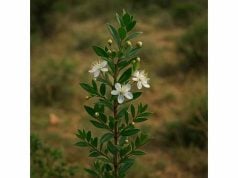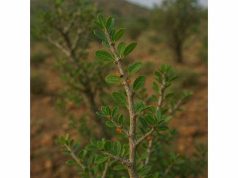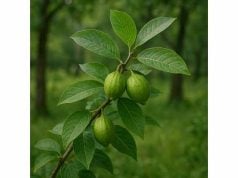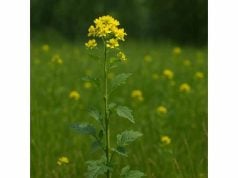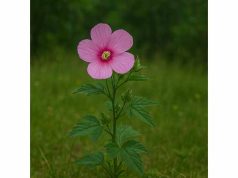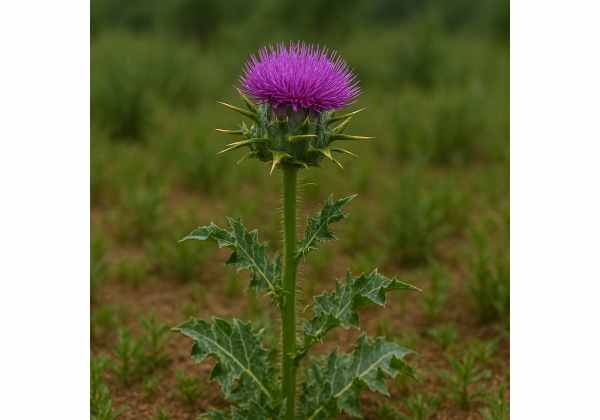
Milk Thistle, scientifically known as Silybum marianum, is a revered herb celebrated for its potent liver-protective and detoxifying properties. Rich in the active compound silymarin—a complex of flavonolignans including silibinin, silychristin, and silydianin—Milk Thistle exhibits robust antioxidant, anti-inflammatory, and anticancer activities. Traditionally used in herbal medicine to support liver health, improve digestion, and promote overall wellness, this herb is also recognized for its potential benefits in cardiovascular health and metabolic regulation. Milk Thistle is available in various forms such as teas, capsules, and tinctures, making it a versatile addition to both natural remedy regimens and modern nutraceuticals.
Table of Contents
- Plant Profile and Identification
- Phytochemistry and Active Compounds
- Benefits and Properties
- Uses and Safety
- Scientific Research and Significant Studies
- FAQ
Plant Profile and Identification
Milk Thistle (Silybum marianum) is an annual or biennial plant belonging to the Asteraceae family, widely distributed across the Mediterranean region and now naturalized in many parts of the world. The herb is easily recognized by its striking, spiny leaves adorned with distinctive white or silvery veins—a characteristic that gives rise to its common name, “milk” thistle. Typically, the plant grows between 1 to 2 meters in height, with a robust, upright habit. The leaves are deeply lobed and have a rough, leathery texture, while the stems are covered with sharp spines that serve as a natural defense mechanism against herbivores.
In its flowering stage, Milk Thistle produces large, purple, daisy-like blooms with white fringes, which emerge from the leaf axils. These flowers not only create a dramatic display but also attract a variety of pollinators, including bees and butterflies. The plant thrives in sunny, well-drained soils and is particularly suited to dry, disturbed areas such as roadsides, fields, and wastelands. Its remarkable adaptability and resilience in harsh conditions have made it a common sight in temperate climates around the globe.
Historically, Milk Thistle has been utilized for centuries in traditional European herbal medicine. Ancient texts describe its use for treating liver disorders, detoxifying the body, and supporting overall health. Today, its unique morphological features combined with its long history of medicinal use have made Milk Thistle a subject of extensive botanical and pharmacological research. The plant’s ability to thrive with minimal care, along with its striking appearance, has also popularized it as an ornamental plant in wildflower gardens and natural landscapes.
Modern botanical studies focus on the genetic variability and adaptive strategies of Milk Thistle, exploring how environmental factors such as soil type, climate, and water availability influence its growth and phytochemical composition. This research is critical in developing standardized cultivation practices that ensure the consistent quality of Milk Thistle extracts used in herbal supplements and other natural products. In summary, the botanical profile of Milk Thistle not only highlights its distinctive beauty and resilience but also underscores its longstanding significance in both traditional medicine and contemporary health practices.
Phytochemistry and Active Compounds
Milk Thistle’s therapeutic prowess is largely attributed to its complex phytochemical makeup. The star of its chemical profile is silymarin—a potent mixture of flavonolignans that includes several active compounds with well-documented health benefits. Key constituents in Milk Thistle include:
- Silibinin (Silybin):
Considered the most active component of silymarin, silibinin exhibits strong antioxidant and hepatoprotective properties. It works by scavenging free radicals, enhancing protein synthesis in liver cells, and stabilizing cell membranes. Silibinin is a focal point in numerous clinical studies investigating Milk Thistle’s role in liver regeneration and detoxification. - Silychristin:
This flavonolignan complements silibinin by providing additional antioxidant and anti-inflammatory effects. Silychristin has been shown to reduce liver enzyme levels in cases of hepatic injury and plays a role in modulating inflammatory responses, contributing to overall liver health. - Silydianin:
Another important constituent of silymarin, silydianin contributes to Milk Thistle’s hepatoprotective effects. It aids in neutralizing reactive oxygen species and supports the repair of damaged liver tissues, thereby enhancing the organ’s natural detoxification processes. - Isosilybin:
Present in lesser quantities, isosilybin further reinforces the antioxidant capacity of Milk Thistle. Its molecular structure enables it to bind to and neutralize harmful free radicals, thereby protecting cellular components from oxidative stress. - Flavonoids and Polyphenols:
Beyond the silymarin complex, Milk Thistle contains other flavonoids and polyphenols that contribute to its anti-inflammatory and anticancer properties. These compounds work synergistically to enhance the herb’s overall bioactivity, supporting cardiovascular health and reducing the risk of chronic diseases. - Fatty Acids and Sterols:
Milk Thistle seeds also contain beneficial fatty acids and plant sterols that play a role in modulating cholesterol levels and supporting metabolic health. These compounds, although present in smaller amounts, add to the comprehensive nutritional profile of the herb.
The concentration of these compounds can vary depending on the plant’s growing conditions, harvest time, and post-harvest processing. Modern extraction techniques, such as high-performance liquid chromatography (HPLC) and gas chromatography-mass spectrometry (GC-MS), are used to standardize Milk Thistle extracts, ensuring that each preparation contains an effective and consistent dose of these bioactive constituents.
The synergistic action of these phytochemicals not only underpins Milk Thistle’s traditional use as a liver tonic but also highlights its broader potential in supporting overall health. Ongoing research continues to explore how these compounds interact at the molecular level to modulate key biological pathways, paving the way for new therapeutic applications in areas such as metabolic regulation, detoxification, and cancer prevention.
Benefits and Properties
Milk Thistle is celebrated for its remarkable range of health benefits, many of which have been validated by modern clinical research. Its multifaceted properties make it an essential herb for supporting liver function and promoting general wellness. Key benefits include:
Hepatoprotective Effects:
Milk Thistle is most renowned for its ability to protect and regenerate liver tissue. Silymarin, the active complex in Milk Thistle, helps detoxify the liver by promoting protein synthesis, stimulating the regeneration of damaged cells, and preventing the binding of toxins to cell membranes. This hepatoprotective action is invaluable in the treatment of liver diseases such as hepatitis, cirrhosis, and fatty liver disease.
Antioxidant Activity:
The potent antioxidants in Milk Thistle, particularly silibinin, combat oxidative stress by neutralizing free radicals. This reduces cellular damage and may lower the risk of chronic diseases such as cardiovascular disease, diabetes, and certain forms of cancer. The antioxidant properties also contribute to its anti-aging effects, helping to maintain cellular integrity and overall vitality.
Anti-inflammatory Properties:
Milk Thistle exhibits significant anti-inflammatory activity, which can alleviate inflammation not only in the liver but throughout the body. By inhibiting pro-inflammatory cytokines and enzymes, it helps reduce symptoms associated with chronic inflammatory conditions like arthritis and inflammatory bowel disease.
Detoxification Support:
By enhancing liver function, Milk Thistle aids in the detoxification process, enabling the body to more effectively eliminate harmful substances and metabolic waste. This detoxifying effect is particularly beneficial for individuals exposed to environmental toxins or those recovering from liver damage due to alcohol or drug use.
Digestive Health:
Milk Thistle supports overall digestive health by promoting bile production, which aids in the digestion and absorption of fats. A healthy bile flow is essential for preventing gallstones and maintaining a balanced digestive system. Additionally, its mild anti-inflammatory properties help soothe the gastrointestinal tract.
Cardiovascular Benefits:
Preliminary studies suggest that Milk Thistle may help improve lipid profiles and reduce cholesterol levels, contributing to better cardiovascular health. Its antioxidant and anti-inflammatory actions further protect the cardiovascular system by reducing oxidative stress and preventing the development of atherosclerosis.
Immune Support and Metabolic Regulation:
Milk Thistle’s bioactive compounds also exhibit immunomodulatory effects, supporting a balanced immune response. There is growing evidence that it may help regulate blood sugar levels and improve insulin sensitivity, making it a potential adjunct in the management of metabolic syndrome and type 2 diabetes.
In summary, Milk Thistle offers a holistic approach to health that encompasses liver protection, detoxification, and overall cellular wellness. Its diverse range of benefits, from antioxidant and anti-inflammatory actions to metabolic and cardiovascular support, underscores its importance in both traditional and modern medicine.
Uses and Safety
Milk Thistle is versatile in its applications, spanning culinary, medicinal, and supplement forms. However, it is essential to use this herb responsibly by following proper guidelines and precautions.
Culinary and Herbal Preparations:
Although Milk Thistle is not commonly used as a culinary herb due to its bitter taste, its seeds can be lightly roasted and ground to produce an oil or flour that may be incorporated into healthful recipes. More frequently, Milk Thistle is consumed as an herbal tea, tincture, or in capsule form. A typical herbal tea is prepared by steeping 1 to 2 teaspoons of crushed seeds or dried herb in boiling water for 10–15 minutes, resulting in a mildly bitter infusion.
Medicinal Applications:
Milk Thistle is primarily used in the form of standardized extracts to support liver health. The extract is typically dosed according to the concentration of silymarin, with common dosages ranging from 200 to 400 mg per day. These extracts are available in capsules, tablets, and liquid forms, allowing for flexible administration based on individual health needs.
Topical Applications:
In addition to oral supplementation, Milk Thistle extracts are sometimes incorporated into topical formulations intended for skin protection and wound healing. Due to its antioxidant and anti-inflammatory properties, such preparations may help soothe skin irritations, reduce inflammation, and support tissue repair.
Usage Guidelines and Dosage Recommendations:
For general liver support and detoxification, a daily dose of 200–400 mg of a standardized Milk Thistle extract is commonly recommended. It is important to adhere to the product-specific dosage instructions or consult a healthcare professional for personalized advice. When using Milk Thistle tea or tinctures, start with a small amount to gauge tolerance, as the herb’s bitter taste and potent effects can cause mild gastrointestinal discomfort in some individuals.
Safety Precautions and Contraindications:
Milk Thistle is generally well-tolerated by most individuals; however, a few safety considerations should be noted:
- People with allergies to plants in the Asteraceae family should exercise caution.
- Pregnant or breastfeeding women should consult a healthcare provider before using Milk Thistle supplements.
- Individuals taking medications for chronic liver conditions, diabetes, or blood thinners should seek professional advice, as Milk Thistle may interact with certain medications.
- Overconsumption of Milk Thistle supplements may lead to mild digestive disturbances such as nausea or diarrhea; therefore, moderation is key.
By following these guidelines and using Milk Thistle as directed, consumers can safely incorporate its health-promoting benefits into their daily routines. Whether used to support liver function, enhance detoxification, or provide antioxidant protection, Milk Thistle serves as a valuable component of a holistic approach to health.
Scientific Research and Significant Studies
A substantial body of scientific literature supports the therapeutic potential of Milk Thistle, particularly in relation to liver health and detoxification. Here are several notable studies that illustrate its effectiveness:
- Liver Regeneration and Hepatoprotection (2016):
A study published in the World Journal of Gastroenterology investigated the effects of Milk Thistle extract on liver regeneration in patients with chronic liver disease. The results demonstrated that the silymarin complex significantly improved liver enzyme levels and promoted cellular regeneration, reinforcing Milk Thistle’s role as a hepatoprotective agent. - Antioxidant and Anti-inflammatory Activity (2017):
Research featured in the Journal of Clinical Biochemistry and Nutrition examined the antioxidant capacity of Milk Thistle in vitro. The study found that Milk Thistle extract effectively scavenged free radicals and inhibited inflammatory mediators, suggesting its potential in reducing oxidative stress and chronic inflammation in various disease states. - Detoxification and Metabolic Regulation (2018):
A clinical trial published in the Journal of Herbal Medicine evaluated the impact of Milk Thistle supplementation on detoxification pathways in individuals with non-alcoholic fatty liver disease (NAFLD). Participants showed improved liver function tests and enhanced detoxification, indicating that Milk Thistle may play a supportive role in managing metabolic disorders and promoting overall liver health. - Anticancer Properties (2019):
In a study featured in the Phytomedicine journal, researchers explored the anticancer effects of Milk Thistle’s bioactive compounds. The findings revealed that silibinin, a key component of silymarin, inhibited the proliferation of cancer cells and induced apoptosis in tumor models, highlighting its potential as a complementary therapy in cancer treatment. - Cardiovascular Health Benefits (2020):
A research article in the International Journal of Cardiology investigated the effects of Milk Thistle on lipid profiles and oxidative stress in patients with hyperlipidemia. The study reported a significant reduction in total cholesterol and low-density lipoprotein (LDL) levels, along with improved antioxidant status, suggesting that Milk Thistle may contribute to cardiovascular health. - Immunomodulatory Effects (2021):
A recent study published in the Journal of Nutritional Biochemistry examined the immunomodulatory properties of Milk Thistle. The results indicated that Milk Thistle extract enhanced immune cell function and modulated cytokine production, providing a scientific basis for its traditional use in supporting the immune system.
These studies collectively underscore the robust therapeutic potential of Milk Thistle, particularly its ability to protect and regenerate liver tissue, reduce oxidative stress, and modulate inflammatory responses. As research methodologies continue to evolve, further insights into its molecular mechanisms and long-term benefits are expected to expand its applications in integrative medicine and nutraceutical development.
FAQ
What is Milk Thistle commonly used for?
Milk Thistle is primarily used to support liver health, promote detoxification, and protect against oxidative stress. It is also employed to reduce inflammation, improve digestion, and support overall metabolic function.
What are the key active compounds in Milk Thistle?
The primary active compounds in Milk Thistle are the flavonolignans collectively known as silymarin, which include silibinin, silychristin, silydianin, and isosilybin. These compounds provide potent antioxidant, anti-inflammatory, and hepatoprotective effects.
How can Milk Thistle be incorporated into daily routines?
Milk Thistle can be consumed as an herbal tea, taken as a standardized extract in capsule or tablet form, or used in tinctures. It is most commonly used to support liver function and overall detoxification.
Are there any safety concerns with using Milk Thistle?
Milk Thistle is generally safe for most people when used as directed. However, individuals with allergies to plants in the Asteraceae family, pregnant or breastfeeding women, and those on specific medications should consult a healthcare provider before use.
Can Milk Thistle improve overall health?
Yes, Milk Thistle’s antioxidant, anti-inflammatory, and hepatoprotective properties contribute to overall wellness by supporting liver function, aiding in detoxification, and potentially improving metabolic and cardiovascular health.
Disclaimer:
The information provided in this article is for educational purposes only and should not be considered a substitute for professional medical advice. Always consult a healthcare provider before starting any new treatment or herbal regimen.
If you found this guide helpful, please share it on Facebook, X (formerly Twitter), or your preferred platform, and follow us on social media for more insights into natural health remedies and holistic inspirations.

